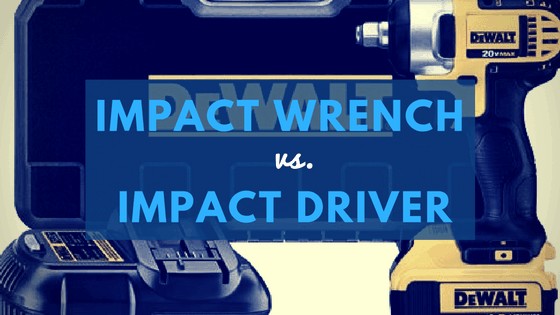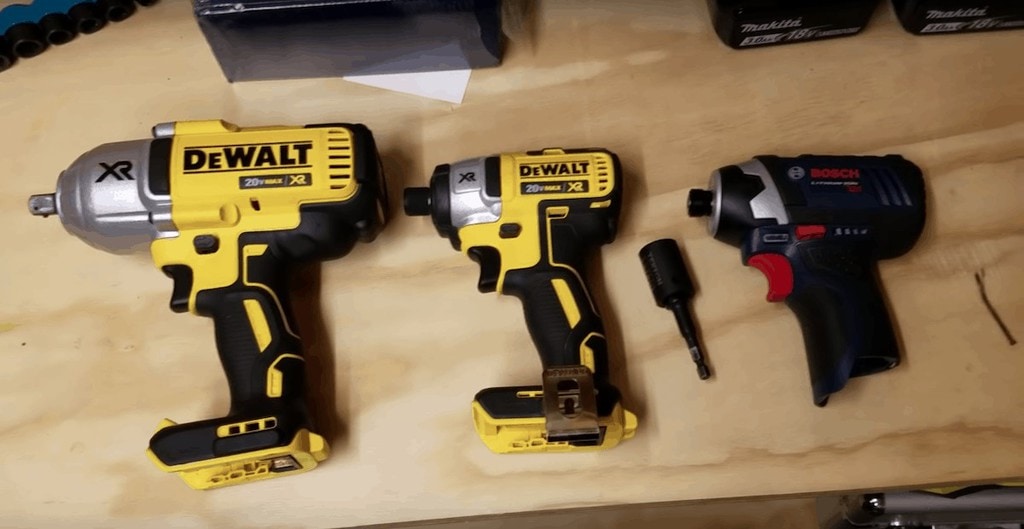Before the popularity of the impact driver, DIY’ers basically had two options when it came to power-wrenching (or driving): the torque wrench, and the standard electric drill. The drill was the go-to option for general purpose driving, drilling, and fastening, while the powerful wrench was typically used in automotive repair/restoration (removing lug nuts, frame/chassis bolts, etc).
Quick Look: Our Top Choices
[sc name="Impact Drivers Impact Wrenches"]
Then the impact driver was introduced to the market.
These sleek, compact little things delivered more torque than a standard drill, and were much more convenient to use than giant, heavy impact wrenches.
So what’s the major differences between the two? In this article, we’ll discuss the discrepancies between impact wrenches and impact drivers, and go over some specific circumstances where each one is more effective.
General overview: Impact Wrench vs. Impact Driver
In general, impact wrenches are heavier, bulkier, and much more powerful (have more torque) than impact drivers. Also, impact wrenches use a square drive (generally ½”) and are made for loosening/fastening sockets, while most impact drivers use a ¼” hex drive and are used for driving screws. (However, ¼” impact drivers can easily be converted to a ½” square drive with a simple adaptor bit like this one, allowing you to use it with socket drivers).
How much more torque do impact wrenches have than impact drivers?
A lot. For reference, this Milwaukee M18 Fuel cordless impact driver (one of the best/most powerful on the market) has about 2,200 in. lbs of torque. It’s behemoth of a cousin, the M18 ½” impact wrench, delivers over 6x this amount - about 13,000 in. lbs.
Now, unless you’re renovating a semi-truck in your driveway, this amount of power is useless for most around-the-house type jobs.
Impact drivers are excellent for situations where standard drills just don’t have enough umph, but impact wrenches are absolute overkill for general purpose use (driving screws, drilling holes, etc).
They are used almost exclusively as high-torque wrenches for removing big, extremely tight sockets (like what you’d find on an automobile). You know that high-pitched, sonic-sounding drill you hear whenever you go to the mechanic or auto shop? Those are impact wrenches.
Both impact wrenches and impact drivers function similarly, in that they use concussive rotational blows to the driver to maximize torque (instead of just spinning, like standard drills do).
Imagine you’re using a standard socket wrench to remove a stuck bolt. You can’t loosen it under your own strength, so you take a small sledge hammer and bang on the wrench repeatedly until it breaks loose.
This is what impact wrenches and drivers do - deliver concussive rotational blows to maximize torque. For a full-length article on impact drivers and their function/uses, check out our article here.
Also, here’s a great video showcasing the major differences between impact wrenches and impact drivers.
When to use an impact wrench vs. impact driver
Like we mentioned, the vast majority of average homeowners and DIY’ers probably won’t have much need for an impact wrench; for around-the-house jobs and light automotive work (removing oil pan bolts, lug nuts, etc), you can easily get away without one.
Would it be nice to have one lying around to zip lug nuts off and rotate the tires with?
Sure.
But unless you’re willing to make a significant investment, you’re probably better off just using a 4-way lug wrench like you’ve been using since you were 15 years old.
Impact drivers, on the other hand, are very practical for DIY/home use, and have become super popular over the years - they’re more compact and deliver more torque than a standard cordless drill, but they’re infinitely more user-friendly than a full-size impact wrench.
Also, most halfway decent impact drivers on the market nowadays will have enough torque to remove lug nuts from cars (probably the only use you’d have for an impact wrench anyway). All you need, like we said, is the ¼” hex to ½” square drive adaptor bit.
Looking to buy?
In professional automotive garages or any halfway respectable fabrication shops, impact wrenches are necessities. If you think you need one for your home garage, though, here’s a short list of some decent ones to consider.
Pro-quality wrenches will set you back well over $300, but there are a few options out there for the average DIY’er that can be picked up for less than 150 bucks.
Buy Impact Wrenches
Ingersoll-Rand 231C ½”
Last update on 2024-11-01 / Affiliate links / Images from Amazon Product Advertising API
This is a great quality tool with the standard ½” square drive - it delivers over 5,000 in. lbs of torque, and comes in at a very manageable price tag. However, it’s a pneumatic wrench, so you’ll need an air compressor to run it. The Ingersoll-Rand 261 is the 231C’s larger, ¾” cousin; a true beast with over 13,000 in. lbs of torque.
DeWalt DCF880HM2 Cordless ½” Kit
Last update on 2024-02-05 / Affiliate links / Images from Amazon Product Advertising API
This kit is actually a pretty good deal - it comes with two 4.0 amp 20V MAX batteries, and the wrench itself delivers about 1,800 in. lbs of torque - not bad, but most decent quality impact drivers nowadays will deliver about the same amount of power.
Porter-Cable PCE210 ½” Corded
Last update on 2022-11-30 / Affiliate links / Images from Amazon Product Advertising API
If it were us, and we were considering adding an impact wrench to the mix, we’d go with something like the PCE210 from Porter Cable. It’s corded so it’s not as convenient as a cordless option, but with the affordable price tag, it’ll allow you to add a practical new tool to the arsenal for next to nothing. Delivers nearly 3,000 in. lbs of torque, so it’s a good deal more powerful than even the best impact drivers out there.
Buy Impact drivers
For a full review of some of our favorite impact drivers, check out our in-depth article here.
Milwaukee 2656-21 M18 Cordless ¼” Impact Driver
Last update on 2022-05-02 / Affiliate links / Images from Amazon Product Advertising API
Probably the best cordless impact driver on the market, if you were to take a general consensus. Milwaukee’s M18 batteries are renowned as being the best of the best - they charge lightning fast and will last as long as any in the business.
The driver itself delivers almost 2,200 in. lbs of torque - an astonishing number for such a sleek, comfortable, user-friendly tool.
Makita XDT111 ¼” Cordless Impact Driver
Last update on 2022-05-04 / Affiliate links / Images from Amazon Product Advertising API
Slightly less quality performance-wise than the Milwaukee 2656, but an absolutely fantastic tool at a much more attractive price. Delivers nearly 1,500 in. lbs of torque - more than enough for general home and light automotive work.
DeWalt DCF885C1 20V MAX ¼” Impact Driver
Last update on 2022-05-04 / Affiliate links / Images from Amazon Product Advertising API
Comes with a compact 1.5 amp 20V MAX battery - a great value for the price. With the compact battery, though, you won’t get a lot of heavy-duty use out of the tool on a single charge. For powerful tools like impact drivers, you’re really better of going with the bigger 4.0 amp batteries. Delivers about 1,400 in. lbs of max torque.
Summary/Bottom Line
So the bottom line is, impact wrenches are much more powerful than impact drivers. However, most typical DIY’ers will not find much use for the insanely high torque that these wrenches put out.
Impact drivers are much more practical tools for the average user, and with a standard hex to square drive adaptor bit they can easily be converted into an impact wrench and used with socket drivers.








